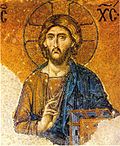- Nikephoros Kallistos Xanthopoulos
-
Part of a series on Eastern Christianity 
History Orthodox Church History
Specific regions:
Byzantine Empire
Ecumenical council
Christianization of Bulgaria
Christianization of Kievan Rus'
East-West Schism
Asian Christianity
Coptic Egypt · UkraineTraditions Orthodox Church
Others:
Oriental Orthodoxy
Ethiopian Tewahedo Church
Coptic Church
Church of the East
Eastern Catholic Churches
Syriac ChristianityLiturgy and worship Sign of the cross
Divine Liturgy
Iconography
Asceticism
OmophorionTheology Hesychasm · Icon
Apophaticism
Filioque clause
Miaphysitism
Monophysitism
Diophysitism
Nestorianism
Theosis · Theoria
Phronema · Philokalia
Praxis · Theotokos
Hypostasis · Ousia
Essence vs. Energies
MetousiosisNikephoros Kallistos Xanthopoulos, latinized as Nicephorus Callistus Xanthopulus (Greek: Νικηφόρος Κάλλιστος Ξανθόπουλος), of Constantinople, the last of the Greek ecclesiastical historians, flourished around 1320.
His Historia Ecclesiastica, in eighteen books, brings the narrative down to 610; for the first four centuries the author is largely dependent on his predecessors, Eusebius, Socrates Scholasticus, Sozomen, Theodoret and Evagrius, his additions showing very little critical faculty; for the later period his labours, based on documents now no longer extant, to which he had free access, though he used them also with small discrimination, are much more valuable.
A table of contents of another five books, continuing the history to the death of Leo VI the Wise in 911, also exists, but whether the books were ever actually written is doubtful. Some modern scholars are of opinion that Nicephorus appropriated and passed off as his own the work of an unknown author of the 10th century. The plan of the work is good and, in spite of its fables and superstitious absurdities, contains important facts which would otherwise have been unknown.
Only one manuscript of the history is known; it was stolen by a Turkish soldier from the library at Buda during the reign of Matthias Corvinus of Hungary and taken to Constantinople, where it was bought by a Christian and eventually reached the imperial library at Vienna.[1]
Nicephorus was also the author of lists of the emperors and patriarchs of Constantinople, of a poem on the capture of Jerusalem, and of a synopsis of the Scriptures, all in iambics; and of commentaries on liturgical poems.
References
- ^ For this history and events leading up to the first modern editions of the book, see Franco Mormando, "Nicephorus and the Battle of the Books Between Catholics and Protestants" in his essay, "Pestilence, Apostasy and Heresy in Seventeenth-Century Rome," in Piety and Plague: From Byzantium to the Baroque, ed. F. Mormando and T. Worcester, Kirksville: Truman State University Press, 2007, pp. 265-71.
- Migne, Patrologia Graeca vol. 145 - Greek text and Latin translation.
 This article incorporates text from a publication now in the public domain: Chisholm, Hugh, ed (1911). "Nicephorus Callistus Xanthopoulos". Encyclopædia Britannica (11th ed.). Cambridge University Press. http://www.1911encyclopedia.org/Nicephorus_Callistus_Xanthopoulos.
This article incorporates text from a publication now in the public domain: Chisholm, Hugh, ed (1911). "Nicephorus Callistus Xanthopoulos". Encyclopædia Britannica (11th ed.). Cambridge University Press. http://www.1911encyclopedia.org/Nicephorus_Callistus_Xanthopoulos.
Categories:- Byzantine historians
- 14th-century writers
- 14th-century historians
- 14th-century Byzantine people
- 14th-century Christians
- History of Christianity texts
- Byzantine people stubs
Wikimedia Foundation. 2010.
